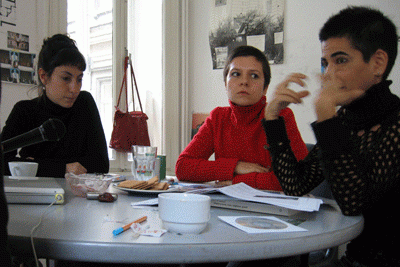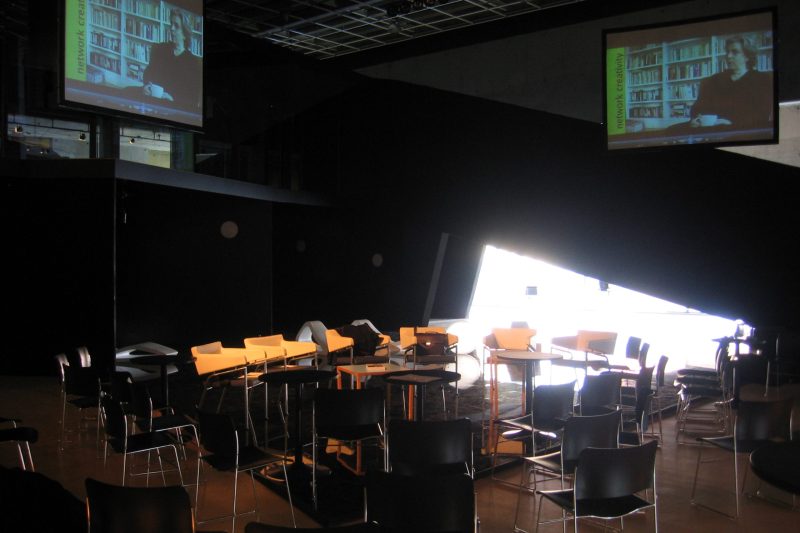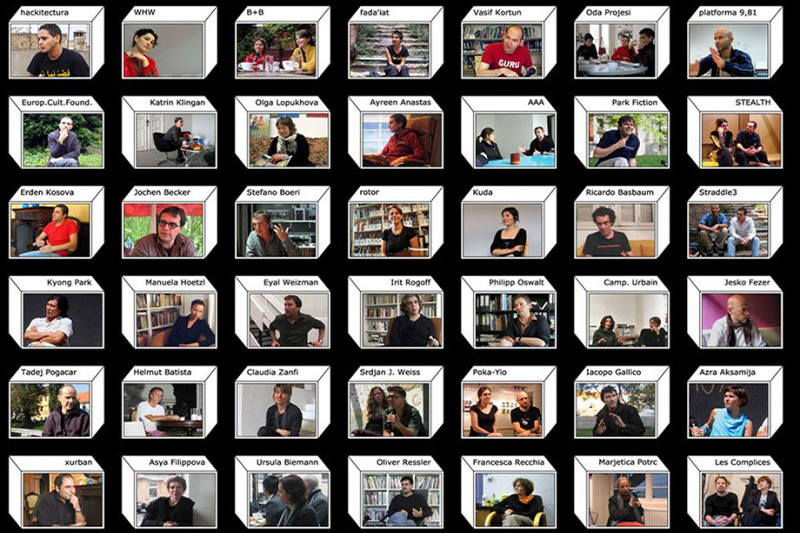- Interview
- London
- 04.10.2005
- NETWORKED CULTURES
CONVERSATION WITH SOPHIE HOPE AND SARAH CARRINGTON
Peter Mörtenböck/Helge Mooshammer: Can you describe how you work together as B+B and how this collaborative curatorial practice has developed its particular approach?
Sarah Carrington: We were interested in looking at how you could present projects that were investigating people, or were using people, or were working with people, and how you could support the point of encounter more effectively. And also to try and create more of a terminology around that practice, because it felt like a lot of it was being simplified or dismissed or confused with community art legacies, so we were trying to look more closely at those distinctions.
Sophie Hope: It feels like now there are a lot of conferences, papers, and symposia which investigate socially engaged art practice, and that’s something that we felt has changed a lot since we’ve been working over the 5 years. But also something that’s been really key to our practices is the UK context, it’s our starting point. We’ve had a New Labour government since we’ve been working together and the impact on cultural policy has been so massive. It’s interesting for us to find out how it’s affected practice and how artists are really dealing with this issue of art being used to change social situations in quite a pragmatic way. But we are trying to think about how artists and curators can connect up beyond their own contexts by creating meeting points beyond the safety of their own back yards.
PM/HM: Part of your work closely follows creative practices and cultural networks in south-eastern Europe; what kind of insights do you gain from this research in relation to working in Great Britain?
Sarah Carrington: There’s such a preconceived idea about what socially engaged practice might be here, and we’ve been really interested in finding examples that are emerging in different contexts. By demonstrating to audiences here that it’s not just about New Labour, that this practice has a long legacy, and there are lots of people working around the world in different ways, and with different motivations, but they need to be given space. We’re trying to inform audiences and open up ideas of what socially engaged practise might be – because I think it’s such a loaded term here, now. For example with Trading Places, the exhibition we did at the Pump House Gallery (London, 2004), we were bringing together examples of artists who were working with migration as an issue or working with migrants or refugee communities – and in Britain those projects are perceived as coming from a particular kind of government line, that ‘you must include those who are socially excluded’ and artists must make people’s lives better and give voice to communities. And then we went to Vienna and found people saying ‘I want to give voices to migrants in my work’, so we were interested in where was that coming from, was that to do with some sort of trend, or was it to do with a genuine social conscience, and if it was, what do they really want to change and how do they think the art is going to change it? So by bringing projects from that context to the UK, we were saying that these artists are doing this not with a governmental or cultural policy baggage, so how can we access that here, and how can we learn from that approach here, and how could we also not simplify every single socially engaged project to be merely a response to funding?
It’s also the crisis of the left more widely. In the Real Estate exhibition we had in the ICA (London, 2005), we presented a project by Lorraine Leeson and Peter Dunn, which took place from the eighties to early nineties called ‘The Docklands Community Poster Project’. Lorraine said herself that she would never use that approach now because it was so specific to that moment; it was so anti-Thatcher and based in the ideals of the left at that time, that that’s impossible now, because that sort of figure is no longer there, and there isn’t the distinction at all. It’s neo-liberal policies in action now, and that’s where culture is very useful as a kind of outlet, somehow.
We were just so interested in that history and the way that Lorraine and Peter worked so precisely with community groups, and their relationships to the local council. But it was so much directly initiated by the community with them, rather than by an agency or by a council inviting them in (which is how such projects might happen today), and so we just wanted to use that as a really important example of asking how, when something isn’t funded, or official in that capacity, what the potential of it is?
Nowadays, the project would be funded by the docklands corporation (the development body the community activists were working against), so that would be the difference. And they would claim that culture was really contributing to the change, that it was improving the residents’ lives – whereas Lorraine was using her role to say ‘look: these people are really angry; we need to let everyone know about how angry we are, and how can I help you do that?’, rather than kind of having a brief from an agency that was about to affect communities’ lives in a detrimental way.
Sophie Hope: Yesterday I went to see a project a friend is working on in Farnborough, as part of Slough Estates’ big development project of the old Ministry of Defence airfields there and turning it into a big business and leisure park. Amy Plant is the artist and she set up a Friends scheme of local residents to decide what to do with a certain so called ‘public’ patch of land within this development. I was talking to one of the local residents who was on that Friends scheme that she set up, and his motivation for being on it is because he’s worried about his house price; he’s worried that his house price will go down because of the business park, so being involved in the Friends Scheme is a way of him having a say on the proposed development. This raises the question, how is an artist implicated in supporting values, politics or principles they might not necessarily endorse or that could even be at odds with the point of the project. A platform such as the Friends Scheme is a mechanism for people with different views and concerns to make decisions about a patch of ‘public space’, it is not judging people’s motivations for getting involved. For example, in the process of raising awareness of shared, communal space the art project might enable people instead to find a way to protect the value of their private property. The artist/initiator has to ask themselves if they are happy to facilitate such a process – how does it fit with their own politics and is this important?
PM/HM: Your Reunion project is very fittingly positioned in this context, trying to appropriate the space of institutional boundaries that such projects are usually exposed to. How do you structure this networking process and how do you keep it political?
Sarah Carrington: In Reunion, we have this structure in which the partners that we’re working with will help to decide on how best Reunion will operate, so we haven’t set down a structure. I think by inviting people we already know we have common interests with, and who know about us as well, it’s more like we’re actually learning from each other, and again, that we can look at how we maybe don’t need to rely on institutions so much; how can we use a union structure – maybe just to pretend – to strengthen our work as independent organisations or as self-organising groups; how can we use that as a model, and potentially then impact on infrastructure in south-eastern Europe as well.
Sophie Hope: Our networking, through Reunion for example, or attending conferences and symposia, is really floating on and supported by the things that we’re trying to constantly shift, change, and subvert or whatever. We’re being paid to network, subvert and critique. The only reason we’re here and we’re doing what we’re doing is because there’s a capitalist system that keeps it afloat. So that is our big question: how can we sink it – but then do we go down with it?

B+B, London
Sarah Carrington and Sophie Hope worked in partnership from 2000-2006 as B+B. Together they organised exhibitions, workshops and events as well as developing an ongoing archive, researching and writing on socially engaged art practice in the UK and internationally. Past B+B curatorial projects have included Notion Nanny, a touring project around the UK with artist Allison Smith (various venues, 2005-06), Real Estate: Art in a Changing City, as part of London in Six Easy Steps (Institute of Contemporary Arts, London 2005), Trading Places – Migration, representation, collaboration and activism in contemporary art (Pump House Gallery, London 2004) and B+B at Home, a six month programme of residencies, exhibitions and events (Austrian Cultural Forum, London 2003). Since 2006 Sarah and Sophie have worked on independent projects and research.


